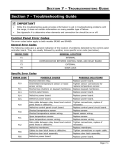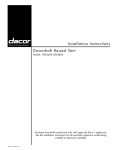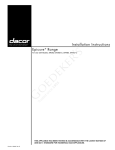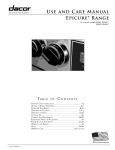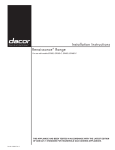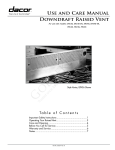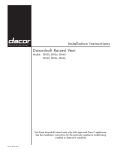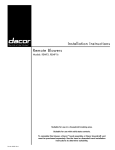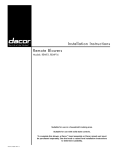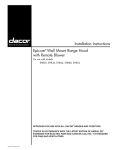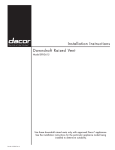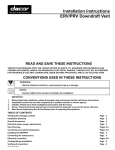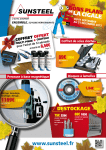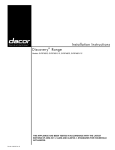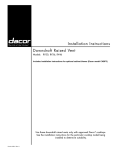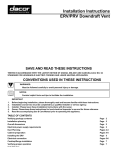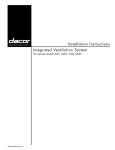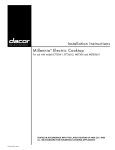Download Dacor REMP3 Specifications
Transcript
Installation Instructions Downdraft Raised Vent Models: ERV36-ER, ERV48-ER These downdraft vents are designed for use with Dacor ® ER36D and ER48D series ranges. Part No. 103106 Rev. C Tested in accordance with the latest edition of ANSI Z 21.1 standard for household gas cooking appliances, ANSI/UL 858 household electrical ranges, CAN/CSA-C22.2 NO. 64 Standard for Household Electric Cooking and Liquid Heating Appliances, and UL 507 electric fans . All specifications subject to change without notice. Dacor assumes no liability for changes to specifications. © 2007 Dacor, all rights reserved. Table of Contents Before You Begin............................................................... 1 Important Safety Instructions........................................... 1 Important Information About Safety Instructions............... 1 Safety Symbols and Labels.............................................. 1 General Safety Precautions.............................................. 2 Customer Service Information.......................................... 3 If You Need Help............................................................... 3 Appliance Data Plate........................................................ 3 Product Specifications...................................................... 3 Product Dimensions.......................................................... 3 Installation Specifications................................................. 4 Electrical Specifications.................................................... 4 Planning the Installation.................................................... 4 Planning the Duct Work.................................................... 6 Installation Instructions..................................................... 8 Installation Preparation..................................................... 8 Installation......................................................................... 8 Verifying Proper Operation.............................................. 12 Installation Checklist....................................................... 12 Before You Begin... Important: • Installer: In the interest of safety and to minimize problems, read these installation instructions completely and carefully before you begin the installation process. Leave these installation instructions with the customer. • Customer: Keep these installation instructions for future reference and the local electrical inspector’s use. Important Safety Instructions Safety Symbols and Labels Important Information About Safety Instructions • • DANGER The Important Safety Instructions and warnings in these instructions are not meant to cover all possible problems and conditions that can occur. Use common sense and caution when installing, maintaining or operating this or any other appliance. Immediate hazards that WILL result in severe personal injury or death. Always contact the Dacor Customer Service Team about problems and conditions that you don’t understand. See Customer Service Information. Hazards or unsafe practices that COULD result in severe personal injury or death. warning caution Hazards or unsafe practices that COULD result in minor personal injury or property damage. DANGER IMPORTANT: Do not store or use combustible, flammable or explosive vapors and liquids (such as gasoline) inside or in the vicinity of this or any other appliance. Also keep items that could explode, such as aerosol cans, away from the range. Do not store flammable or explosive materials in adjacent cabinets or areas. READ AND SAVE THESE INSTRUCTIONS 1 Important Safety Instructions General Safety Precautions To reduce the risk of fire, electric shock, serious injury or death when using your appliance, follow basic safety precautions, including the following: Warning 1. 2. 3. Do not install or operate this unit if it has been damaged, dropped, has damaged electrical wiring or is not working properly. If the product is damaged when received, immediately contact the dealer or builder. Use this raised vent only for its intended purpose as outlined in the use and care manual. Do not use this unit to vent hazardous or explosive materials or vapors. This appliance is not intended for commercial use. The customer should not install, repair or replace any part of this unit unless specifically recommended in the literature accompanying it. A qualified service technician should perform all other service. Contact the Dacor Customer Service Team for examination, repair or adjustment. warning 11. To reduce the risk of electric shock or fire connect remote blowers with a total combined current draw of eight (8) amps or less. 12. The installer must show the customer the location of the electrical outlet so that the customer knows where and how to disconnect power. 13. Read the use and care manual completely before using this raised vent. 14. Do not tamper with the controls. 15. Never allow the filters or vent openings to become blocked or clogged. Do not allow foreign objects, such as cigarettes or napkins, to be sucked into the vent holes. 4. Keep all packaging materials away from children. Plastic bags can cause suffocation. 16. Clean the filters and all grease-laden surfaces often to prevent grease fires and maintain performance. Clean this appliance only as specified in the use and care manual. 5. This raised vent must be installed and grounded by a qualified installer according to these installation instructions. All installation work and electrical wiring must be performed in accordance with all applicable codes and standards, including fire-rated construction. 17. Do not leave children or pets alone or unattended in the area around the range when it is in use. Never allow children to sit or stand on an appliance. Do not let children play with a range or the raised vent. Do not store items of interest to children above or around the range. 6. Install or locate this appliance only in accordance with these installation instructions and the Dacor range installation instructions. Improper installation, adjustment, alteration, service or maintenance can cause serious personal injury or property damage. 18. Install this raised vent only with Dacor ER36D and ER48D series ranges. 7. Sufficient air is needed for proper combustion and exhausting of gases through the flue (chimney) of fuel burning equipment to prevent back drafting. Follow the heating equipment manufacturer’s guidelines and safety standards such as those published by the National Fire Protection Association (NFPA), and the American Society for Heating, Refrigeration and Air Conditioning Engineers (ASHRAE) and the local code authorities. 8. When cutting or drilling into the wall or ceiling, do not damage electrical wiring and other hidden utilities. 9. Always vent ducted fans to the outdoors. Do not vent exhaust air into spaces within walls or ceilings or into attics, crawl spaces or garages. 10. Before installing or servicing the raised vent, disconnect the power plug from the electrical outlet. 2 19. This appliance is equipped with a three-prong grounding plug for your protection against possible electric shock hazards. It must be plugged into a dedicated, grounded electrical outlet. Where a standard two-prong wall receptacle is encountered, it is the personal responsibility and obligation of the customer to have it replaced with a dedicated, properly grounded three-prong wall receptacle. Do not under any circumstances: • Cut or remove the third (ground) prong from the power cord. • Use an adapter plug. • Use an extension cord. • Use a power cord that is frayed or damaged. • Use of a ground fault interrupter (GFI) is not recommended. Customer Service Information If You Need Help... Appliance Data Plate If you have questions or problems with installation, contact your Dacor dealer or the Dacor Customer Service Team. When you call, have the model and serial number of the appliance ready. The model and serial number are printed on the appliance data label on the front of the unit. The appliance data label also specifies the power supply requirements. Dacor Customer Service Team Phone: Web site: Monday - Friday 6:00 a.m. to 5:00 p.m. Pacific Time Model Identification: ERV36-ER = 36-Inch Raised Vent ERV48-ER = 48-Inch Raised Vent (800) 793-0093 www.Dacor.com Product Specifications Product Dimensions Stiffener across back Model Number 2 1/4" (57 mm) Top Cap Width (A) Chassis Width (B) ERV36-ER 36” (914 mm) 33 3/8” (848 mm) ERV48-ER 48” (1219 mm) 43 3/8” (1102 mm) Tolerances: +1/16”, -0, (1.6 mm,0) unless otherwise stated 1 15/16" (49 mm) 2 13/16" (71 mm) “A” Vent shown in raised 10" position (254 mm) “B” 18 13/16” (478 mm) 3 3/4" (95 mm) 30 ¼" 30 ¼" (768 mm) (768 mm) to 37 ¼" (946 mm) Appliance data label 6" (152 mm) Motor Cover 13/16" (21 mm) 28" 3 prong grounded power cord Adjustable Anchor Legs 3 Installation Specifications warning • • Observe all governing codes and ordinances during planning and installation. Contact your local building department for further information. Planning the Installation System Layout • The electric outlet for the raised vent should be installed only by a licensed electrician. Electrical Specifications The raised vent is supplied with a 28” (711 mm) power cord terminated by a three-prong plug. Plug it directly into a dedicated, grounded, three prong, electrical outlet. Do not use an extension cord. The correct voltage, frequency and amperage must be supplied to the electrical outlet from a grounded, single phase circuit that is protected by a properly sized circuit breaker or time-delay fuse. Electrical Supply Requirements • A 3 prong electrical outlet connected to a 120 Vac, 60 Hz, 15 Amp. grounded, dedicated circuit is required. • The customer must supply conduit with minimum current carrying capacity of 8 Amps to supply power to the remote blower from the raised vent. See Planning the Duct Work for further details. • The above specifications are for reference only. If the power supply requirements shown above do not agree with those listed on the appliance data label, use the required voltage, frequency and amperage ratings on the appliance data label. • It is the owner’s responsibility to ensure that electrical outlet is installed by a licensed electrician. The electrical installation must comply with the latest revision of the National Electric Code ANSI/NFPA 70 (latest revision) and local codes and ordinances. • If the electrical service provided does not meet the product specification, or does not conform to the NEC or local standards, do not proceed with the installation. Call a licensed electrician to correct the electrical service before proceeding. • Locate the electrical outlet in an accessible location, so that the power plug can be disconnected for service without removing the raised vent or the range from the cabinet. The vent system consists of the raised vent itself and a remote blower. You must install a Dacor model REMP3 or REMP16 remote blower for the raised vent to operate properly. For directions on installing the remote blower, see the REMP3/16 installation instructions. warning • Failure to install a remote blower or proper duct work may result in a back draft and/or the insufficient venting of smoke and fumes. • To reduce the risk of personal injury caused by reaching over a hot appliance, cabinet storage space located directly above the range should be avoided. • Do not store combustible materials or items adversely affected by heat in cabinet areas above the appliance. • Follow the instructions and diagrams for minimum safe clearances and installation location. Failure to do so may result in a fire or safety hazard. • Wire the remote blower to turn on when the raised vent is turned on by running a piece of conduit parallel to the duct work and connecting it to the raised vent on one end and the remote blower on the other. There are 7/8” access holes in the bottom and side of the raised vent for connecting the conduit. Vent shown in down position Side Bottom Conduit Access Hole Locations • 4 The raised vent exhaust may be configured to vent through the back, the bottom or through one of the sides. The maximum allowable duct run must be taken into consideration when determining the layout. See Planning the Duct Work for further details. Installation Specifications • • • • Install the raised vent and range so that they can be removed if service is required. Countertop Height: The raised vent is equipped with adjustable anchor legs to accommodate various cabinet heights. See Product Dimensions. Max: 37 ¼” (946 mm) Plan the installation so that all minimum dimensions are met or exceeded. All contact surfaces between the raised vent and any cabinets or walls must be solid and at right angles. Refer to the range installation instructions for the minimum dimensions specific to the particular range being installed. Backsplash Min: 30 ¼” (768 mm) 1/4" (6 mm) Min. flat ledge Vertical non-combustible surface rear wall C Allow room for the exhaust duct coming out of the unit. See Planning the Duct Work for further details. Model Number ERV Cutout Width (C) Range Cutout Width (D) Min. ERV36-ER 33 1/2” (848 mm) 36 1/16” (916 mm) ERV48-ER 43 1/2” (1102 mm) 48 1/16” (1221 mm) 2 13/16" (71 mm) 10" (254 mm) Min. * * Depth dimensions are at the discretion of the customer. For reference, depth of the ER36D/ER48D range is 28 ¼” (718 mm) from the front panel, excluding trim and knobs. to combustible side walls above the range (both sides) D Cabinet Cutout - Top View REMP Series Remote Blower All tolerances: +1/16”, -0, (1.6 mm,0) unless otherwise stated Outside Wall Wall Board Duct work between ERV and remote blower REMP Series Remote Blower Backsplash Cabinet Back ERV Wall Board ERV ER36D or ER48D Range ERV configured for rear exhaust ER36D or ER48D Range ERV configured for bottom exhaust Floor Floor Power conduit from ERV to remote blower Example of Layout with Rear Exhaust (Side View) Duct work between ERV and remote blower Example of Layout with Bottom Exhaust (Side View) 5 Installation Specifications Planning the Duct Work warning • To reduce the risk of fire and to properly exhaust air, be sure to duct air outside the house or building. Do not vent exhaust air into spaces within walls or ceilings or into attics, crawl spaces or garages. • Tape all duct joints securely to prevent combustion by-products, smoke or odors from entering the home. Doing so will also improve system efficiency. • Do not exhaust more than one vent into a single duct run. • For proper operation this unit must be installed with a remote blower. Use only Dacor models REMP3 or REMP16. • Use only duct work constructed of materials deemed acceptable by state, municipal and local codes • DO NOT install an additional in-line or external blower to increase the length of the duct run. Even small differences between blower air flow rates can greatly reduce the air draw by the hood. 6 1/2" (165 mm) Side Side Exhaust Duct Exhaust Duct Side Exhaust Duct 3 1/4" x 10" Rear Exhaust Duct Bottom Exhaust Duct 3 1/4" x 10" Motor Rear Exhaust Cover Duct Bottom Exhaust Duct • When connecting the duct work to the back of the unit, the customer must supply a 3 ¼” X 10” rectangular transition to make the connection. • For side and bottom exhaust connections, use the supplied ATD2 transition to connect the duct work to the unit. It transitions between the narrow exhaust outlet on the unit and a 3 ¼” X 10” rectangular duct connection. On bottom exhaust installations cut a hole in the floor to allow the transition and/or duct work to pass through the floor. 6 • On side exhaust installations, allow five inches of space on the side for the ADT2 exhaust transition plus additional space for the duct attached to it (X). X 5” ATD2 The ERV raised vent can be configured to exhaust through the back, the bottom or either side. 25 15/16" (659 mm) • ADT2 Transition • All duct work materials (including screws and duct tape) must be purchased separately by the customer. • When planning new duct work, always look for the shortest, most direct route to the outside. • You can increase the duct size over the duct run if desired. To prevent a back draft, never decrease the duct size over the run. • Do not rely on duct tape alone to seal duct joints. Fasten all connections with sheet metal screws and tape all joints with certified silver tape or duct tape. • Use sheet metal screws as require to support the duct weight. • To prevent back-drafts, a damper at the duct outlet may also be required. • Make sure duct work does not interfere with floor joists or wall studs. • With concrete slab construction, “box-in” the duct work to prevent it from collapsing when the wet concrete is poured. Also allow room for electrical conduit from the remote blower. • Cross-drafts or air currents caused by adjacent open windows or doors, heating/air conditioning outlets, ceiling fans and recessed ceiling lights reduce vent efficiency. Installation Specifications Duct Work Design Tips • Wherever possible, reduce the number of transitions and turns to as few sharp angles as possible. Two staggered 45° angles are better than one 90°. Keep turns as far away from the hood exhaust as possible, with as much space between each bend as possible. • For best performance, use round duct instead of rectangular, especially when elbows are required. • If multiple elbows are used, try to keep a minimum of 24” of straight duct between them. Avoid “S” or “back to back” configurations of adjacent elbows. • In regions where the weather gets extremely cold, thermal breaks, such as a short section of non-metallic duct, should be used to avoid indoor heat loss. The break should be located as close to the pass through point to the outside as possible. • Do not use flexible metal duct. Calculating the Maximum Duct Run Length • Do not use duct work that is smaller in cross-sectional area than the required duct sizes in the table to the right. • For best performance, keep the duct run as short as possible and never exceed the maximums stated below. • The maximum straight duct length for the raised vent system depends on the model of remote blower used with vent system and the number of elbows and transitions used. The equivalent number of feet for each elbow and transition must be subtracted from the maximum straight length to compensate for wind resistance To determine the maximum allowable length of the duct work, subtract all of the equivalent lengths of the elbows and transitions listed below from appropriate Maximum Equivalent Straight Lengths. For example, for a raised vent system using 10 inch duct, a REMP3 remote blower and three (3) 90° elbows: • From the Maximum Equivalent Straight Lengths table, the maximum length without transitions and elbows is 40 feet. • The total equivalent length of the three (3) 90° 10 inch elbows is 3 X 5 feet = 15 feet. • The maximum amount of straight duct that can be used with a REMP3 and the elbows is: 40 feet - 6 feet = 34 feet. Duct Size Used Maximum Equivalent Straight Lengths of Duct Work Using Model REMP3 Remote Blower Using Model REMP16 Remote Blower 8 Inch 50 feet (15.2 meters) 60 feet (18.3 meters) 10 Inch 40 feet (12.2 meters) 70 feet (21.3 meters) 3 ¼” X 10” 40 feet (12.2 meters) 60 feet (18.3 meters) 3 1/4" x 10" 90° Elbow 3 1/4" x 10" 45° Elbow Transistion 3 1/4" to 8” Round Transistion 3 1/4" to 10" Round 15 Feet 7 Feet 4 Feet 4 Feet 3 1/4" x 10" 90° Flat Elbow 45° Elbow Round Duct 90° Elbow Round Duct 90° Transistion 3 1/4" x 10" to 8" Round 20 Feet 8" Diameter - 3 Feet 10" Diameter - 2 Feet 8" Diameter - 7 Feet 10" Diameter - 5 Feet 25 Feet Equivalent Lengths - Duct Elbows and Transitions 7 Installation Instructions Installation Preparation 2. Cut and remove the foil material inside the knock-out hole. If you fail to remove the foil, the vent will not work. Verify Package Contents 3. If the unit will vent through the bottom or side: • • Use and care manual • Anchoring legs • 4 wood screws for anchor legs • 3 wire nuts • ADT2 duct transition • 2 sheet metal screws for ADT2 mounting • 2 nuts and washers to secure anchor legs • Insulation foam For side installations, attach the supplied ATD2 transition to the side of the unit that will exhaust the air. Install an elbow to the transition with the output pointing down. ADT2 side installation Verify that the raised vent and blower being installed are a matched pair before beginning the installation. Installation warning • If the electrical service (electrical outlet) does not meet the Electrical Specifications on page 4, do not proceed with the installation. Call a licensed electrician and have an electrical outlet installed that meets the specifications. Install the vent only in a vertical orientation. Do not mount the vent on a slant or angle. ADT2 bottom installation Installing the Raised Vent 1. Remove the appropriate side, back or bottom exhaust knockout, depending on the duct configuration, from the raised vent assembly by cutting the metal cross overs and removing the insert. ADT2 Transition Installation • For bottom installations, attach the supplied ATD2 transition to the bottom of the unit. Cut a hole in the cabinet floor to allow the exhaust transition and/or the duct to pass through the floor. Back of Unit Side Knock-out Side Knock-out Top of vent resting on countertop Cut hole in floor to allow duct to pass through on bottom venting installations Rear knock-out with metal cross overs shown Bottom Knock-out Vent Knock-out Locations 8 Floor Installation Instructions 4. If the unit will exhaust air from the back, attach a 3 1/4” X 10 duct to the vent hole created by removing the knock-out on the back of the unit. 5. Loosely attach the anchoring legs to the studs on the left and right sides of the raised vent using the provided hex nuts and washers. Installing the Remote Blower and Ducts 1. Install the remote blower according the remote blower installation instructions. 2. Install the duct work between the remote blower inlet and the exhaust of the raised vent according to the Installation Specifications. Use sheet metal screws and duct tape to connect all of the pieces. Support the duct weight as necessary to ensure sealed joints. Front of Raised Vent REMP Series Remote Blower Anchor Leg Put nuts/ washers on studs Wall Board 6. Place the vent into the rear of the countertop cutout with the electrical access panel toward the front. Backsplash Top of vent resting on countertop Anchor Leg Electrical Access Panel ERV ER36D or ER48D Range Duct work between ERV and remote blower ERV configured for rear exhaust Floor Floor 7. Adjust the anchoring leg height so that the end caps are gently resting on the counter, then tighten the hex nuts. 8. Secure the anchoring legs to the cabinet floor with the screws provided. Conduit that supplies power from ERV to remote blower (see Electrical Installation, page 10) Example of Installation with Rear Exhaust (Side View) 9 Installation Instructions Electrical Installation warning ELECTRIC SHOCK HAZARD - Do not connect power to the unit until installation is complete. 1. Run the conduit line used to supply power from the raised vent to the remote blower parallel to the duct work. 2. Make sure the raised vent power plug is disconnected from the electrical outlet. 3. Remove the cover from the raised vent electrical access panel. 4. Connect the conduit to the remote blower as shown in the wiring diagrams on this page and the facing page. 5. Replace the electrical access panel. Match wire colors to terminals as shown Wires to power plug Pre-wired at factory Do not modify BLACK Power Input Ground Electrical Access Panel Blower Output WHITE GREEN ERV Raised Vent Front View Attach ground wire as shown To power conduit Connect other end of wires to remote blower terminal block ERV Electrical Access Panel 10 Installation Instructions Wires from power conduit. Connect other end of wires to “Blower Output” inside ERV electrical access panel Match wire colors to terminals as shown N1 L1 BLACK WHITE GREEN Gnd ERV Outside Wall Gnd N1 L1 Remote Blower Terminal Block Remote Blower Wiring REMP Series Remote Blower ER36D or ER48D Range See ERV electrical access panel on facing page Floor Power conduit from ERV to remote blower Example of Installation with Bottom Exhaust (Side View) Range Installation Install the range according to the range installation instructions. Once the range is installed, make sure that the top cap on the raised vent intake does not catch on the back edge of the range when the intake is lowered. If interference does occur, adjust the position of the range by moving it against the front edge of the countertop cutout. Make sure the vent anchoring legs are properly secured to the cabinet base with the supplied wood screws. Failure to eliminate any interference may result in permanent damage to the vent. 11 Installation Instructions Verifying Proper Operation warning • Read the raised vent use and care manual completely before operation. • Install all of the front filters prior to operating the raised vent. Refer to the use and care manual for filter installation instructions. caution To prevent damage to the raised vent power cord, route it away from the surfaces of the range before connecting it. 1. Make sure the power switch on the top of the raised vent is in the up position. 2. Plug the raised vent power plug into the electrical outlet. 3. Press the power switch once to raise the vent to its operating position. 4. Once in the up position, turn the variable speed control switch in both directions to verify that the blower is operating correctly. Turn the variable speed control switch counter-clockwise to hi-speed and clockwise to low speed. 5. Press the top cap up/down switch once to lower the vent. Installation Checklist □□ Are the anchor legs extended down to make contact with the floor and tightened into place? Are the anchor legs fastened to the floor? Is the unit level? □□ Is the duct work completely installed? Are all joints attached with sheet metal screws and wrapped with duct tape? □□ Is the power input for the remote blower connected to the raised vent electrical access panel? □□ Are the vent filters installed according to these instructions? □□ Is the power cord routed away from the hot surfaces of the range. □□ Is the unit connected to an electrical outlet that meets the electrical specifications in these instructions? □□ Has proper operation been verified? □□ Have any problems been noted on the warranty card or during the on-line activation? Has the warranty been activated on-line or the warranty card been filled out completely and mailed? 12 Dacor ● 1440 Bridge Gate Drive, Diamond Bar, CA 91765 ● Tel: (800) 793-0093 ● FAX: (626) 403-3130 ● www.Dacor.com
















